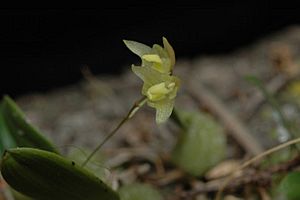Tiny strand orchid facts for kids
Quick facts for kids Tiny strand orchid |
|
|---|---|
 |
|
| Cultivated specimen of Bulbophyllum exiguum | |
| Scientific classification | |
| Genus: |
Bulbophyllum
|
| Species: |
exiguum
|
| Synonyms | |
|
|
The Bulbophyllum exiguum, also known as the tiny strand orchid, is a special type of orchid. It grows on other plants or rocks. This orchid is found only in eastern Australia. It has small, roundish parts called pseudobulbs. Each pseudobulb has one leaf. Up to three small, creamy white or yellow flowers grow from the base of these pseudobulbs. This orchid likes to grow in rainforests and dry forests. It often covers tree branches or rocks where it lives.
What the Tiny Strand Orchid Looks Like
The tiny strand orchid is a small plant. It can grow on other plants (epiphytic) or on rocks (lithophytic). Its pseudobulbs are usually 5 to 10 mm long. They are shaped like small spheres. Each pseudobulb tapers, or gets narrower, towards the leaf.
Each pseudobulb has one leaf. These leaves are about 25 to 30 mm long. But their size can change a lot. The flowers are small and can be creamy white or yellow. The sepals, which are like outer leaves of the flower, are about twice as long as the petals.
The flowers grow on a thin stalk. This stalk usually holds up to three flowers. It comes out from the base of a pseudobulb. Sometimes, it grows from the rhizome, which is like an underground stem, between the bulbs. The bulbs can be spaced out or grow close together. They are often clustered when the plant is young. This orchid produces its flowers between March and May.
How the Tiny Strand Orchid Got Its Name
The tiny strand orchid was first officially described in 1860. A scientist named Ferdinand von Mueller wrote about it. He published his description in a book called Fragmenta phytographiae Australiae.
The second part of its scientific name, exiguum, comes from a Latin word. This word means "small," "short," "poor," or "scanty." This name fits the orchid well because it is quite small.
Where the Tiny Strand Orchid Lives
This orchid grows on trees and rocks. You can find it in Queensland and New South Wales. It lives in subtropical and temperate rainforests. It also grows in sclerophyll forests. In these places, it often covers rock faces, tree trunks, or branches.
It can be found at high places, up to 1,000 meters (about 3,280 feet) above sea level. It needs a warm, shady, and humid place to grow well.


